|
|
 |
|
Calanoida ( Order ) |
|
|
|
Clausocalanoidea ( Superfamily ) |
|
|
|
Clausocalanidae ( Family ) |
|
|
|
Clausocalanus ( Genus ) |
|
|
| |
Clausocalanus pergens Farran, 1926 (F,M) | |
| | | | | | | Syn.: | no Clausocalanus pergens : Mori, 1937 (1964) (p.35); Tanaka, 1960 (Pl.XII, figs.F, M) | | | | Ref.: | | | Farran, 1926 (p.239, Descr.F, figs.F); 1929 (p.208, 224); Tanaka, 1956 cp.383, Rem.F); Vervoort, 1957 (p.38, Rem.); ? Park, 1968 (p.541, figs.F); Frost & Fleminger, 1968 (p.66, figs.F,M, Rem.); Carli & Crisafi, 1969 (p.280, figs.F); Corral Estrada, 1970 (p.142); Razouls, 1972 (p.94, Annexe: p.36, figs.F); Bradford, 1972 (p.36, figs.F); Williams & Wallace, 1975 (p.175, fig.F, Rem.); Dawson & Knatz, 1980 (p.7, figs.F,M); Björnberg & al., 1981 (p.629, figs.F,M); Alvarez-Marques, 1981 (p.157, figs.F, Rem.); Bradford-Grieve, 1994 (p.124, figs.F,M, fig.101); Chihara & Murano, 1997 (p.777, Pl.91,92: F,M); Bradford-Grieve & al., 1999 (p.878, 916, figs.F,M); Bucklin & al., 2003 (p.335, tab.2, fig.1, Biomol); Blanco-Bercial & Alvarez-marqués, 2007 (p.73, fig.2, Biomol.); Avancini & al., 2006 (p.82, Pl. 51, figs.F,M, Rem.); Vives & Shmeleva, 2007 (p.625, figs.F,M, Rem.) | 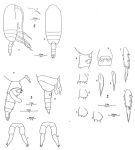 issued from : B. Frost & A. Fleminger in Bull. Scripps Inst. Oceanogr. Univ. California, San Diego, 1968, 12. [Pl. 51, p.202-203; Pl.52, p.204-205; Pl.53, p.206-207]. Female: 1 a, habitus (right lateral view); 1 b, idem (dorsal view); 1 c, rostrum (right lateral); 1 a-c taken from different specimens; 2 a , Th.4-5 (posterior part) and genital segment (right lateral); 2 b, genital segment (ventral view); 2 c-d, B2 of P2; 2 e-f, B2 of P3; 2 g, St of P2; 2 h, St of P3; 2 i, Re3 and St of P3; 2 j, Re3 and St of P4; 2 a-b taken from different specimens; 2 c, e from a third; 2 d-f from a fourth; 2 g-h from a fifth; 2 i-j from a sixth; 3 a, Th.4-5 (posterior part) and urosome with spermatophore attached (right lateral view); 3 b, Th.2 (posterior part), Th.3, Th.4-5 and urosome (right lateral view); 3 c-d, P5; 3 a-d taken from different specimens. Nota: A1 segment 2 less than 0.95 times as long as segment 24. Exopodal segment 3 of P3 less than 1.20 times as long as terminal seta of P3. Exopodal segment 3 of P4 less than 1.30 times long as terminal seta of P4..
|
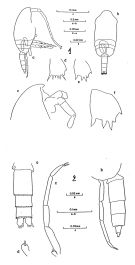 issued from : B. Frost & A. Fleminger in Bull. Scripps Inst. Oceanogr. Univ. California, San Diego, 1968, 12. [Pl. 54, p.208-209; Pl.55, p.210-211]. Male: 1 a, habitus (right lateral view); 1 b, idem (dorsal view); 1 c, frontal region (right lateral view); 1 d, B2 of P2; 1 e-f, B2 of P3; 1 a-b from different specimens; 1 c from a third; 1 d-e from a fourth; 1 ffrom a fifth; 2 a, urosome (armature of caudal rami incomplete) (dorsal view); 2 b, Th.4-5 (posterior part) and urosome (left lateral view); 2 c, P5 (right posterolateral); 2 d, right P5; 2 a-b from different specimens; 2 c-d from a third. Nota: Total body length less than 0.80 mm.
|
 issued from : C. Razouls in Thèse Doc. ès Sciences, Univ. P & M. Curie, Paris , Tome annexe, 1972, Fig.37 (unpublished). Female (from Banyuls): A, habitus (lateral right side); B, urosome (ventral); C, P5; D, basipod 2 of P2; E, basipod 2 of P3; F, idem; G, exopod 3 of P2; H, exopod 3 of P3; I, A1; J, basipod 2 of P2; K, basipod 2 of P3.
|
 issued from : B. Frost & A. Fleminger in Bull. Scripps Inst. Oceanogr. Univ. California, 1968, 12. [p.78, Table 4a]. Clausocalanus pergens Females: Measurements and ratios . TL = total body length ; SL = spermatophore length ; P :U = ratio of prosome length to urosome length ; U :U1 = ratio of total urosome length to length of 1st urosomal segment (genital segment) ; S :U1 = ratio of spermatophore sac length to U1 length of female on which spermatophore is attached ; r = sample range; m = sample mean; n = number of specimens measured; s = sample standard deviation.
|
 issued from : B. Frost & A. Fleminger in Bull. Scripps Inst. Oceanogr. Univ. California, 1968, 12. [p.79, Table 4b]. Clausocalanus pergens Males: Measurements and ratios . TL = total body length; P :U = ratio of prosome length to urosome length ; P:U2 = ratio of prosome length to length od 2nd urosomal segment; U2:2P5 = ratio of U2 length to length of 2nd segment of longer ramus of P5; U2:3P5 = ratio of U2 length of 3rd segment of longer ramus of P5; 3P5:2P5 = ratio of length of 3P5 of longer ramus to length of 2P5 of longer ramus; r = sample range; m = sample mean; n = number of specimens measured; s = sample standard deviation.
|
 issued from : B. Frost & A. Fleminger in Bull. Scripps Inst. Oceanogr. Univ. California, 1968, 12. [p.21, Fig.4]. Exopodal segment 3:terminal seta length ratio of P4 (ordinate) plotted against length of exopodal segment 3 of P4 (abscissa) for females of Clausocalanus pergens.
|
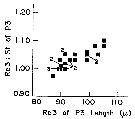 issued from : B. Frost & A. Fleminger in Bull. Scripps Inst. Oceanogr. Univ. California, 1968, 12. [p.20, Fig.3]. Exopodal segment 3:terminal seta length ratio of P3 (ordinate) plotted against length of exopodal segment 3 of P3 (abscissa) for females of Clausocalanus pergens.
|
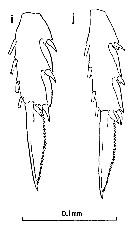 issued from : B. Frost & A. Fleminger in Bull. Scripps Inst. Oceanogr. Univ. California, 1968, 12. [p.205, Pl.52, i, j]. Female: i, exopodal segment 3 and terminal seta of P3; j, exopodal segment 3 and terminal seta of P4.
|
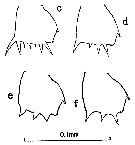 issued from : B. Frost & A. Fleminger in Bull. Scripps Inst. Oceanogr. Univ. California, 1968, 12. [p.205, Pl.52, c-d, e-f]. Female: c-d, basipodite 2 of P2; e-f, basipodite 2 of P3.
|
 issued from : B. Frost & A. Fleminger in Bull. Scripps Inst. Oceanogr. Univ. California, 1968, 12. [p.207, Pl.53, c-d]. Female: c-d, P5 (from different specimens).
|
 issued from : B. Frost & A. Fleminger in Bull. Scripps Inst. Oceanogr. Univ. California, 1968, 12. [p.211, Pl.55, b, c, d]. Male: b, posterior part of last thoracic segment and urosome (left lateral); c, P5 (right posterolateral); d, right P5.
|
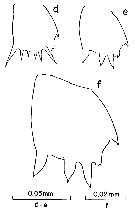 issued from : B. Frost & A. Fleminger in Bull. Scripps Inst. Oceanogr. Univ. California, 1968, 12. [p.209, Pl.54, d, e, f]. Male: d, basipodite 2 of P2; e-f, basipodite 2 of P3; From different specimens.
|
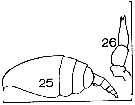 issued from : J.M. Bradford in Mem. N. Z. Oceonogr. Inst., 1972, 54. [p.35, Fig.5 (25-26)]. Female (from Kaikoura, New Zealand): 25, habitus (lateral); 26, P5. Scale bars: 0.1 mm (25, 26).
|
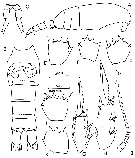 issued from : C. Razouls in Th. Doc. Etat Fac. Sc. Paris VI, 1972, Annexe. [Fig.37]. Female (from Banyuls, G. of Lion): A, habitus (lateral); B, urosome (dorsal); C, P5; D, basipod 2 of P2; E, basipod 2 of P3; F, basipod 2 of P3; G, exopod 3 of P2; H, exopod 3 of P3; I, A1; J, basipod 2 of P2; K, basipod 2 of P3.
|
 issued from : A. Ianora, B. Scotto di Carlo, M.G. Mazzocchi & P. Mascellaro in J. Plankton Res., 1990, 12 (2). [p.255, Fig.6]. Longitudinal section (A) of Clausocalanus pergens parasitized by the phycomycetes (Coelomomycetaceae) which has destroyed most of the body tissue and led to total sexual castration of the host. Close-up of parasite with (B) light microscope and (C) TEM (x 4300). mg = midgut; fc = phycomycetal cells. Scale bar = 0.100 mm.
|
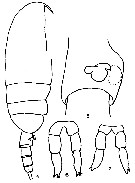 Issued from F. Alvarez-Marques in Rev. Fac. Cienc. Univ. Oviedo (Ser. Biologia), (1979-80), 20-21, 1981. [p.165, Pl. II, Figs.4-7]. Female (from Gijon, NW Spain): 4, habitus (lateral); 5, genital segment and spermatheca (lateral); 6 & 7, P5.
| | | | | Compl. Ref.: | | | Yamazi, 1958 (p.148, Rem.); Grice & Hart, 1962 (p.287, table 3, p.293: Rem.); Duran, 1963 (p.14, Rem.); De Decker & Mombeck, 1964 (p.12); Anraku & Azeta, 1965 (p.13, Table 2, fish predator); Grice & Hulsemann, 1965 (p.223); Mazza, 1966 (p.70); Furuhashi, 1966 a (p.295, vertical distribution in Kuroshio region, Table 10); Fleminger, 1967 a (tabl.1); ? Delalo, 1968 (p.137); Champalbert, 1969 a (? part., p.633); Apostolopoulou, 1972 (p.327, 343); Björnberg, 1973 (p.311, 385); Corral Estrada & Pereiro Muñoz, 1974 (tab.I); Peterson & Miller, 1975 (p.642, 650, Table 3, interannual abundance); 1976 (p.14, Table 1, 2, 3, abundance vs interannual variations); 1977 (p.717, Table 1, seasonal occurrence); Carter, 1977 (1978) (p.35); Kovalev & Schmeleva, 1982 (p.83); Vives, 1982 (p.290); Scotto di Carlo & al., 1984 (p.1041); Tremblay & Anderson, 1984 (p.6: Rem.); Regner, 1985 (p.11, Rem.: p.28); Jansa, 1985 (p.108, Tabl.V); Brenning, 1985 a (p.28, Table 2); Greze & al., 1985 (p.7); Lozano Soldevilla & al., 1988 (p.58); Cervantes-Duarte & Hernandez-Trujillo, 1989 (tab.3); Pancucci-Papadopoulou & al., 1990 (p.199); Hirakawa & al., 1990 (tab.3); Ianora & al., 1990 (p.249, fig.; parsitism effects); Scotto di Carlo & al., 1991 (p.271); Yoo, 1991 (tab.1); Seguin & al., 1993 (p.23); Landry & al., 1994 (p.55, abundance, grazing); Landry & al., 1994 a (p.73, grazing, gut evacuation); Shih & Young, 1995 (p.72); Kotani & al., 1996 (tab.2); Go & al., 1997 (tab.1); Park & Choi, 1997 (Appendix); Noda & al., 1998 (p.55, Table 3, occurrence); Hure & Krsinic, 1998 (p.100); Siokou-Frangou & al., 1999 (p.205, Table 5); Seridji & Hafferssas, 2000 (tab.1); Siokou-Frangou, 1999 (p.476); Razouls & al., 2000 (p.343, Appendix); Moraitou-Apostolopoulou & al., 2000 (tab.I); Holmes, 2001 (p.42); Fragopoulu & al., 2001 (p.49, tab.1); Uysal & al., 2002 (p.17, tab.1); Peterson & al.2002 n (p.381, Table 2, interannual abundance); Sameoto & al., 2002 (p.12); Mackas & Galbraith, 2002 a (p.423, Table 2); Keister & Peterson, 2003 (p.341, Table 1, 2, abundance, cluster species vs hydrological events); Vukanic, 2003 (139, tab.1); Hsiao & al., 2004 (p.325, tab.1); Rezai & al., 2004 (p.489, tab.2, Rem.); Peralba & Mazzocchi, 2004 (p.645, figs.3,6); Fernandez de Puelles & al., 2004 (p.654, fig.7); Lo & al., 2004 (p.89, tab.1); Wang & Zuo, 2004 (p.1, Table 2, dominance, origin); Vukanic & Vukanic, 2004 (p.9, tab. 2, 3); Fernandez & al., 2004 (p.501, tab.5); Mackas & al., 2005 (p.1011, 1021, tab.2); Manning & Bucklin, 2005 (p.233, Table 1)); Zuo & al., 2006 (p.163: tab.1); Isari & al., 2006 (p.241, tab.II); Mackas & al., 2006 (L22S07, Table 2); Zervoudaki & al., 2006 (p.149, Table I); Hooff & Peterson, 2006 (p.2610); Fernandez de Puelles & al., 2007 (p.338, fig.7); Valdés & al., 2007 (p.103: tab.1); Khelifi-Touhami & al., 2007 (p.327, Table 1); Dur & al., 2007 (p.197, Table IV); McKinnon & al., 2008 (p.844: Tab.1); Cabal & al., 2008 (289, Table 1); Morales-Ramirez & Suarez-Morales, 2008 (p.519); Fernandes, 2008 (p.465, Tabl.2); Rossi, 2008 (p.90: Tableau XII); C.-Y. Lee & al., 2009 (p.151, Tab.2); Peterson, 2009 (p.73, Rem.: p 78); Galbraith, 2009 (pers. comm.); Chiba & al., 2009 (p.1846, Table 1, occurrence vs temperature change); Zhang W & al., 2009 (p.261); Brugnano & al., 2010 (p.312, Table 3, fig.8); Lidvanov & al., 2010 (p.356, Table 3); Schnack-Schiel & al., 2010 (p.2064, Table 2: E Atlantic subtropical/tropical, Fig.4, 6, 7, Tabe 4); Mazzocchi & Di Capua, 2010 (p.425); Hafferssas & al., 2010 (p.1281, Table III, abundance vs spatial distribution); Hsiao S.H. & al., 2011 (p.475, Appendix I); Selifonova, 2011 a (p.77, Table 1, alien species in Black Sea); Keister & al., 2011 (p.2498, interannual variation); Mazzocchi & al., 2011 (p.1163, Table II, fig.6, long-term time-series 1984-2006); Isari & al., 2011 (p.51, Table 2, abundance vs distribution); Mazzocchi & al., 2012 (p.135, annual abundance 1984-2006); Shiganova & al., 2012 (p.61, Table 4); Jang M.-C & al., 2012 (p.37, abundance and seasonal distribution); Uysal & Shmeleva, 2012 (p.909, Table I); Salah S. & al., 2012 (p.155, Tableau 1); Miloslavic & al., 2012 (p.165, Table 2, transect distribution); Brugnano & al., 2012 (p.207, Table 2); Jean & al., 2012 (p.12, Table 3, protein vs environmental metal stress); Hidalgo & al., 2012 (p.134, Table 2); Takahashi M. & al., 2012 (p.393, Table 2, water type index); in CalCOFI regional list (MDO, Nov. 2013; M. Ohman, comm. pers.); Tachibana & al., 2013 (p.545, Table 1, seasonal change 2006-2008); Lidvanov & al., 2013 (p.290, Table 2, % composition); Siokou & al., 2013 (p.1313, fig.4, 8, biomass, vertical distribution); Pansera & al., 2014 (p.221, Table 2, abundance); Mazzocchi & al., 2014 (p.64, Table 3, 4, 5, spatial & seasonal composition %); Zaafa & al., 2014 (p.67, Table I, occurrence); Fernandez de Puelles & al., 2014 (p. in press, Table 3); Zakaria & al., 2016 (p.1, Table 1); Benedetti & al., 2016 (p.159, Table I, fig.1, functional characters); Ohtsuka & Nishida, 2017 (p.565, Table 22.1); El Arraj & al., 2017 (p.272, table 2, spatial distribution); Benedetti & al., 2018 (p.1, Fig.2: ecological functional group); Belmonte, 2018 (p.273, Table I: Italian zones); Chaouadi & Hafferssas, 2018 (p.913, Table II: occurrence); Hure M. & al., 2018 (p.1, Table 1: abundance, % composition, Table 2: correlations); Palomares-Garcia & al., 2018 (p.178, Table 1: occurrence). | | | | NZ: | 17 | | |
|
Distribution map of Clausocalanus pergens by geographical zones
|
| | | | | | | | | | | | | | | 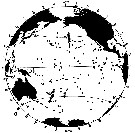 issued from : B. Frost & A. Fleminger in Bull. Scripps Inst. Oceanogr. Univ. California, San Diego, 1968, 12. [p.68, Chart 10, a]. issued from : B. Frost & A. Fleminger in Bull. Scripps Inst. Oceanogr. Univ. California, San Diego, 1968, 12. [p.68, Chart 10, a].
Occurrence of C. pergens in samples examined; closed circles represent samples examined; open circles represent samples in which adults were found; bars through open circles represent samples from which specimens were removed for measurements. |
 issued from : B. Frost & A. Fleminger in Bull. Scripps Inst. Oceanogr. Univ. California, San Diego, 1968, 12. [p.69, Chart 10, b]. issued from : B. Frost & A. Fleminger in Bull. Scripps Inst. Oceanogr. Univ. California, San Diego, 1968, 12. [p.69, Chart 10, b].
Occurrence of C. pergens in samples examined; closed circles represent samples examined; open circles represent samples in which adults were found; bars through open circles represent samples from which specimens were removed for measurements. |
| | | | Loc: | | | sub-Antarct. (Indian), South Africa (E), off S Cape Verde Is., off Morocco-Mauritania, Cap Ghir (Morocco), Canary Is., off Madeira, Azores, Bay of Biscay, S Brazil, G. of Mexico, New-York, G. of Maine, off Nova Scotia E, off S Newfoundland, off Ireland (S & W), Gijon (NW Spain), Iberian Shelf, Morocco-Mauritania, Ibero-moroccan Bay, off W Tangier, Medit. (Alboran Sea, Sidi Fredj coast, Gulf of Annaba, Baleares, Banyuls, Marseille, Toulon Harbour, Ligurian Sea, Napoli, Tyrrhenian Sea, Lake Faro, Strait of Messina, Adriatic Sea, Aegean Sea, Thracian Sea, W Egyptian coast, Lebanon Basin, Black Sea), South Africa (Natal), S Indian, Bay of Bengal, Australia (North West Cape), Straits of Malacca, China Seas (Yellow Sea, East China Sea), Taiwan (SW, E, N: Mienhua Canyon, NW), Okinawa, S Korea, Korea Strait, Nagazaki, Kuchinoerabu Is., Japan, Ishikari Bay, Tokyo Bay, Bikini Is., Pacif. (central N), Pacif. (E equatorial), Vancouver Is., off Washington coast, Oregon (Yaquina, off Newport), California, Santa Monica Basin, W Baja California, La Paz (Mexico), W Costa Rica, S Tasmania, New Zealand (N, Kaikoura, North Island SE), off SE Australia, Ecuador, Chile, off Santiago | | | | N: | 146 | | | | Lg.: | | | (30) F: 1,1-0,7; M: 0,67-0,52; (35) F: 1-0,9; (38) F: 1,05-0,9; (55) F: 0,99; (72) F: 0,94-0,85; (116) F: 0,94; (374) F: 1,025-0,75; (1138) F: 0,98-0,81; M: 0,58-0,55; {F: 0,70-1,10; M: 0,52-0,67}
The mean female size is 0.924 mm (n = 14; SD = 0.1147), and the mean size male is 0.580 mm (n = 4; SD = 0.0648). The size ratio (male : female) is about 0.65. | | | | Rem.: | epipelagic-bathypelagic.
Sampling depth (sub-Antarct.) : 100-250 m.
For Frost & Fleminger (1968, p.70) it is likely that C. pergens, brevipes, and parapergens have been confused in the past. The authors have omitted from the synonymy and geographical records of pergens if adequate descriptive details do not accompany the records. Females of C. pergens are distinguished from brevipes by the body length, the length ratio of A1 segment 2 to 24, the exopodal segment 3/ terminal seta length ratio of P3 and P4, and usually the appearance of the seminal receptacle and thoracic segment IV-V posterior margin, both in lateral view. C. pergens and C. parapergens differ in all of the above characters but body lengt; they also differ in the Prosome/Urosome length ratio and do not appear to overlap in body length at localities where they occur together. C. pergens and furcatus are distinguished from each other by the relative lengths of urosomal segments 1 and 3, the length-width ratio of the caudal ramus, and the shape of the seminal receptacle in lateral view. C. pergensbrevipes in the length of the left P5 relative to the Urosome. C. pergens and parapergens differ in the segment 3/segment 2 of P5 length ratio. C. pergens is distinguished from furcatus by the shape of the rostrum.
Certain localisations are to be confirmed.
After Benedetti & al. (2018, p.1, Fig.2) this species belonging to the functional group 5 corresponding to small sac-spawning detritivorous.
| | | Last update : 28/10/2022 | |
|
|
 Any use of this site for a publication will be mentioned with the following reference : Any use of this site for a publication will be mentioned with the following reference :
Razouls C., Desreumaux N., Kouwenberg J. and de Bovée F., 2005-2026. - Biodiversity of Marine Planktonic Copepods (morphology, geographical distribution and biological data). Sorbonne University, CNRS. Available at http://copepodes.obs-banyuls.fr/en [Accessed January 08, 2026] © copyright 2005-2026 Sorbonne University, CNRS
|
|
 |
 |


















